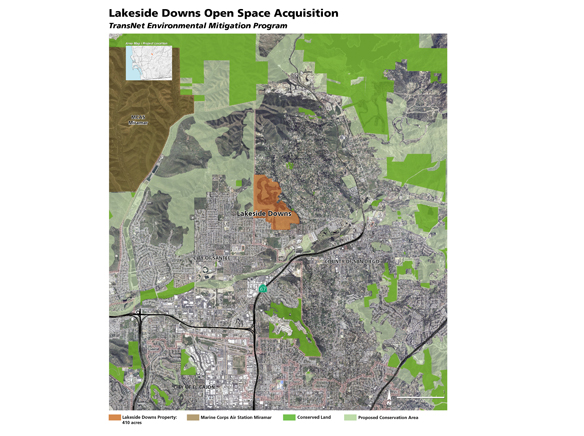By Helen Gao
Collaboration between the Endangered Habitats Conservancy, SANDAG, and the U.S. Department of Defense has resulted in the preservation of a 410-acre property in East County that’s home to valuable habitat and wildlife, including a robust population of the threatened coastal California gnatcatcher.
By Helen Gao
Collaboration between the Endangered Habitats Conservancy, SANDAG, and the U.S. Department of Defense has resulted in the preservation of a 410-acre property in East County that’s home to valuable habitat and wildlife, including a robust population of the threatened coastal California gnatcatcher.
The property known as Lakeside Downs is located west of State Route 67 (SR 67) in the unincorporated Lakeside area, just outside of Santee’s conservation boundaries and about three miles from Marine Corps Air Station (MCAS) Miramar. Previously proposed for a 140-home development, Lakeside Downs contains high-value coastal sage scrub habitat and extensive stands of spiny redberry, host plant for the rare Hermes Copper Butterfly. The property is strategically located, helping to close gaps between lands that are conserved or proposed for conservation.
Through its TransNet Environmental Mitigation Program (EMP), SANDAG contributed $4 million toward the $8 million acquisition. The TransNet EMP is funded by the regional half-cent sales tax for transportation approved by voters countywide in 2004. Through this award-winning program, SANDAG goes above and beyond what is required by law to support environmental conservation and restoration to offset the effects of transportation projects. Savings from prudent management of the EMP has recently allowed SANDAG to provide $20 million in grants to various agencies, such as the Endangered Habitats Conservancy, to acquire key habitat.
The U.S. Department of Defense (DOD) also contributed $4 million toward the acquisition cost under its Readiness and Environmental Protection Integration (REPI) Program. According to the DOD, REPI is “a key tool for combating encroachment that can limit or restrict military training, testing, and operations.” The Lakeside Downs acquisition preserves important habitat beyond the boundary of MCAS Miramar for the California gnatcatcher, which is federally listed as a threatened species. By doing so, the acquisition reduces on-station conservation pressures and restrictions on military readiness training.
“Lakeside Downs is the 34th open space acquisition that SANDAG has helped to complete through the TransNet Environmental Mitigation Program. Thanks to the voter-approved TransNet program, we’ve preserved nearly 3,800 acres of important natural resources to date,” SANDAG Chair and Santee Councilmember Jack Dale said. “The Lakeside Downs acquisition is another example of SANDAG following through with its commitment to voters to make environmental protection a key priority in the region.”
The Endangered Habitats Conservancy (EHC) worked together with all the partners to put together the acquisition and is now the owner and manager of the land. EHC’s mission is to acquire, manage, monitor, and maintain land in California for habitat protection and restoration, agricultural preservation, and other conservation purposes. Incorporated in 2005, EHC currently manages approximately 5,000 acres of conserved lands.
“We all share a responsibility to preserve the unique natural resources and landscapes of our home. But it is not really “ours.” We are temporary caretakers,” Michael Beck, Executive Officer of the Endangered Habitats Conservancy, said. “Conservation of the Lakeside Downs property moves us closer to meeting that aspiration and ensuring that the globally significant ecosystems of San Diego County and Southern California will persist into the future.”
The Conservancy purchased Lakeside Downs from Helix 1960, Ltd. and Helix Land Co., Ltd. It closed escrow on the property on Aug. 30, 2015. SANDAG and the Department of the Navy, on behalf of the U.S. Marine Corps, hold conservation easements over the property, ensuring long-term preservation.














